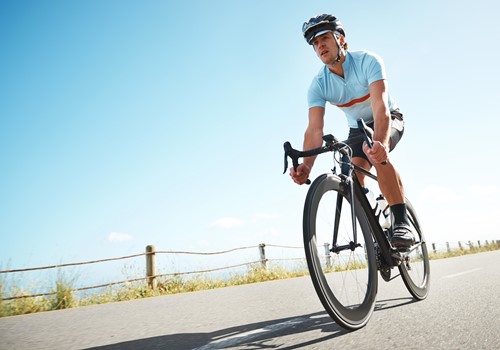The benefits of cycling with a power meter


Cycling with a power meter is steadily growing in popularity, due largely to it becoming more affordable and accessible.
While heart monitors are still perhaps more commonly used in cycling, there are some instances where cycling with a power meter will provide more accurate data.
If you’re an avid road cyclist, cycling with a power meter is a great way to track your progress over time. And because power meters are not affected by external factors such as whether you’ve had enough sleep or whether you’re dehydrated, it’s worth investing in one to get a more detailed look at your training progress.
What is a cycling power meter?
Power meters use strain gauges to measure the force being applied by the cyclist. A power meter is able to measure the power output of the cyclist in real time and isn’t affected by any external factors.
Power meters give you a reading of the amount of energy you’re using in watts. This means you can track the amount of effort you’re applying as you train as well as calculate your fitness level and the amount of calories burnt during a session.
Power meter vs heart monitor
The key difference between using a power meter and a heart monitor is that a power meter measures your power output whereas a heart monitor is measuring your heart rate. Heart rate monitors usually come in two forms, those that you wear on your wrist and those that come in the form of a chest strap.
A heart rate monitor can be used to track when you’re hitting your target zones when you’re cycling in intervals. The caveat to this is that heart monitors usually lag behind slightly in tracking when you’re in that target zone, as your heart rate takes time to rise once you start pushing yourself to go faster, whereas power meters register the increase in force you’re exerting immediately.
Related: Choosing a Heart Rate Monitor

What are the different types of cycling power meters?
Pedal
As you may have guessed, a pedal-based power meter replaces the normal pedals you have on your bike. This makes them easy to install and use compared to some other power meters, and you can even get ones that track each leg individually.
Crank arm
Most crank arm-based power meters you’ll see on the market replace only the left crank arm on your bike. Before you purchase a crank arm-based power meter, make sure you check the compatibility with your current bike as they can cause issues with hitting the bike frame whilst you cycle if you haven’t bought one with the right fit.
Related: Best power meters 2024: pedal and crank-based models
Spider
Cycling with a spider-based power meter can add a fair bit of weight to your bike, but they’re still one of the most popular choices among cyclists. These power meters replace your bike’s crank spider and can fit a wide range of bike types, making it possible to swap between multiple bikes if needed.
Spindle/Axle
A spindle-based power meter sits inside the axle of the crankset of your bike. As they’re quite small in comparison to other power meters out there, they don’t add much weight to your bike.
Related: The 8 Best Power Meters to Gather All Your Training Data

The benefits of cycling with a power meter
1. Achieve more accurate data
As we’ve already mentioned, using a power meter can give you more accurate data that isn’t affected by external factors. This makes them a really useful tool for measuring your improvement over time, as although heart rate monitors can be useful, they can be influenced by various other factors which will affect your heart rate.
For example, drinking coffee, not getting enough sleep, and how hydrated you are can all effect your heart rate reading. This is why if you do want to use a heart rate monitor, it’s a good idea to use both devices in unison to get the most accurate readings of your progress.
2. Use your training time more efficiently
Most cyclists have a finite amount of time to train. When time is limited, using a power meter can help you use your time more efficiently than just cycling aimlessly around a select route.
If you’re training in intervals, a power meter can give you the stats for the amount of effort you’re putting in in real time. With this information, you can keep better track of the amount of time you’re spending in each interval and level of intensity, making your training more efficient.
3. Learn your strengths and weaknesses
The data gathered by the power meter can help give you a clearer view of your strengths and weaknesses in your cycling technique.
For example, if you’ve recently recovered from an injury and are just getting back into training, some power meters are able to feedback on the amount of force applied by each foot separately so you can identify if the amount of pressure you’re applying is uneven.
4. Helps you to plan your races
Once you’ve learned how long for and at what force you can cycle at, you can better plan your intervals during races. This helps you to ensure you’re performing at your best during a competition using the data collected by the power meter during your training.
5. Share data with your coach
If you’re currently training for a race and have a coach you’re working with, you can easily share your training data with them even when you’re apart. This allows your coach to provide you with more accurate advice on how to improve your performance as they’ll be better informed in real time on how you’re improving.
Specialist cycling insurance through Cycleplan
The more you invest in your bike and its accessories, the more you could stand to lose if your bike is stolen or damaged. Insuring your bike and its accessories through Cycleplan can protect them against damage, theft, and loss.
You can also get Public Liability cover through Cycleplan, which can help cover the costs involved should you be deemed liable for injury to another person or damage to third-party property while using your bike.
Find out more about how Cycleplan can help or get a quick online quote today.
Please note the information provided on this page should not be taken as advice and has been written as a matter of opinion. For more on insurance cover and policy wording, see our homepage.
